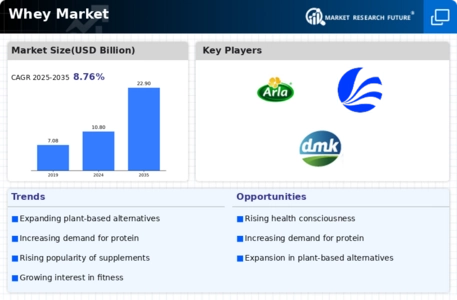Top Industry Leaders in the Whey Market

Competitive Landscape of the Whey Market: Key Players, Strategies, and Market Dynamics
The whey market has witnessed substantial growth as a result of the increasing demand for protein-rich ingredients across various industries, including food and beverages, sports nutrition, and animal feed. Key players in this sector are strategically positioning themselves to capitalize on the growing popularity of whey protein. This analysis provides insights into the key players, strategies adopted, factors influencing market share, emerging companies, industry trends, overall competitive scenario, and a recent development in 2023.
Key Players:
Arla Foods (Denmark)
Westland Co-operative Dairy Company (New Zealand)
Milk Specialties (U.S.)
Agropur MSI LLC (U.S.)
DMK Group (Germany)
American Dairy Products Institute (U.S.)
Glanbia Plc (Ireland)
Davisco Foods Internation Inc (U.S.)
Strategies Adopted:
Market Share Analysis:
New & Emerging Companies:
Industry Trends:
Recent industry developments highlight a growing trend towards sustainable whey production. Major players are investing in sustainable practices, including energy-efficient processing, waste reduction, and exploring circular economy initiatives. Additionally, there is increased attention to upcycling whey byproducts, such as converting whey permeate into value-added ingredients, aligning with the industry's commitment to environmental responsibility.
In terms of investment trends, companies are exploring technologies to enhance the nutritional profile of whey products. Investments in research and development focus on developing whey ingredients with enhanced functional properties, such as improved solubility, flavor profiles, and bioavailability.
Competitive Scenario:
The competitive landscape of the whey market is dynamic, with established players adapting to emerging trends and new entrants exploring innovative solutions. The focus on product innovation, vertical integration, and market expansion remains central to the overall competitive scenario.
Recent Development
The whey market was the increased emphasis on the functional properties of whey proteins in the cosmetic and personal care industry. Major players introduced whey-derived ingredients for skincare and haircare formulations, leveraging the unique properties of whey proteins to enhance product efficacy. This development aligns with the growing consumer interest in natural and functional ingredients in personal care products. Companies invested in marketing campaigns highlighting the benefits of whey proteins for skin and hair health, contributing to the expansion of whey applications beyond traditional food and nutrition sectors. This shift towards the cosmetic industry reflects the industry's recognition of the versatility of whey proteins and their potential in diverse consumer applications.


